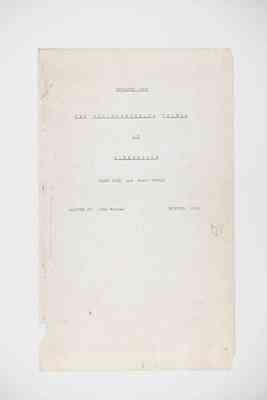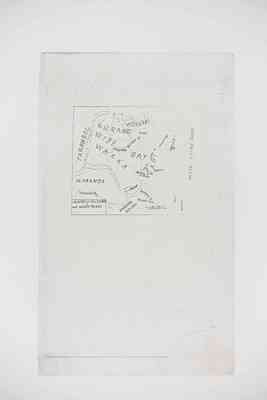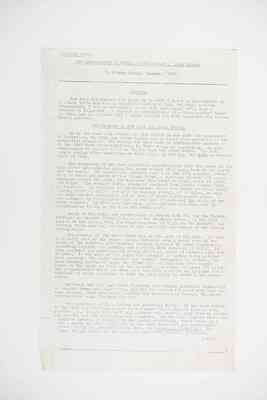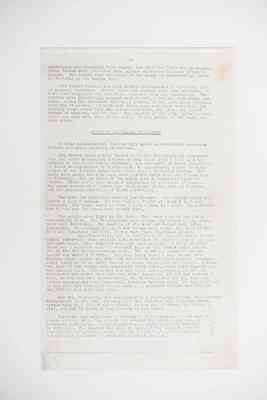Pages
1
"Two representative tribes of Qld" /John Matthew, 1910. (extracts)
1038239
2
EXTRACTS FROM
T W O R E P R E S E N T A T I V E S T R I B E S
O F
Q U E E N S L A N D
(KABI KABI and WAKKA WAKKA)
WRITTEN BY: John Mathew PRINTED: 1910
3
WOKKARI GURANG Gwolla? TARAMBOL WIDE BAY [Burnett R]] Maryborough FRASER I. SOUTH PACIFIC OCEAN Gayndoh/ [Mary R]] WAKKA Klaeiran? KABI Gympie Bomder? [Morumber?]] WIDDEL? MARANDA CONDAMINE R ? Brisbane R DARLING DOWNS MORETON TURUBUL Bribie I. Moreton I.
4
EXTRACTS FROM :—
TWO REPRESENTATIVE TRIBES OF QUEENSLAND - John Mathew
T. Fisher Unwin; London; 1910
PREFACE
For over six consecutive years up to 1872 I lived in the country of the Kabi tribe and was in constant touch with Kabi and Wakka natives. Subsequently I was in occasional touch with them until 1876, when I removed to Melbourne. I renewed my acquaintance by a three months' visit in 1884, and in October 1906 I again visited the Kabi territory and interviewed natives.
THE COUNTRY OF THE KABI AND WAKKA TRIBES
As is the case with nearly all the tribes in teh east and south-east of Australia, the Kabi and Wakka tribes are so named from negatives in the respective dialects. The reason for this mode of nomenclature appears to be the fact that these negatives, by their frequent repetition, are more conspicuous to member of alien tribes than any other words. The Kabi people employ other negatives as well, viz., wa and bar, but kabi is distinctive of them.
The territory of the Kabi coincided approximtely with the basin of the Mary River but extended along the coast beyond that basin both to the north and the south. Its coast-line extended from near the 27th parallel northward to about the mouth of the Burrum River, a distance of some 175 miles ; measured across the land, the distance from point to point would be about 130 miles. The maximum width, measured westward from Double Island Point, is 85 miles. In addition to the mainland, there was Fraser or Great Sandy Island, about 85 miles long with an average breadth of 12 miles, so that the Kabi country altogether had an area of about 8,200 square miles. I was informed by the natives that at one time it embraced the whole of the bunya country. If this were the case, encroachments had been made by neighbouring tribes on the west and south-west.
South of the Kabi, and having much in common with it, was the Turubul (Ridley) or Turrbal (Petrie) tribe of the Brisbane River. At the Kabi limits on the north, from the coast westward to Walla on the Burnett, the Wokkari tribe came in, and west of its territory the domain of the Gurang Gurang began.
The country of the Wakka Wakka lay to the west of the Kabi. It took in a small part of the Dawson basin, extended over a great part of the basin of the Burnett, its boundary passing eastward by about Coonambula, including Gaynday, and meeting the northern Kabi boundar at Walla. It also included the upper waters of the Brisbane, where it marched with the Turubul. To the west of the Wakka the Tarumbol or Dawson River natives were located. The Wakka country was roughy triangular in outline, the Creek on the south to Walla on the Burnett, a distance of about 125 miles. The perpendicular would run west near the 26th parallel of latitude for a distance of about 80 miles, so that the area would be about 5,000 square miles.
Although the Kabi and Wakka dialects are largely distinct, especially as regards nouns and adjectives, yet the two tribes followed very much the some customs, they were very friendly and intermarried freely, the class restrictions being the same for both.
This territory of both tribes was generally hilly. At the head waters of the Mary and Brisbane Rivers it was mountainous and, in places, even picturesque. It was in almost all season well watered with flowing rivers and creekds, and the vegetation was abundant. In the Kabi country there are extensive scrubs, especially on the higher elevations, where there is a great variety of plant-life, one of the most beautiful and conspicuous ?atures being the graceful bunya tree, the Araucaria Bidwillii. The kernels in the flakes of the cones of this tree formed a palatable, (over)
5
-2nutritious and plentiful food supply, and when the fruit was in season, other tribes were attracted from immense distances to enjoy Nature's bounty. The scrubs were the haunt of the wawun or scrub-turkeey, known in Victoria as the Mallee hen.
The forest country was well wooded and abounded in marsupial game of several varieties. Native bears and possums were very numerous, as were also kangaroos and wallabies, kangaroo rats and bandicoots. The streams were plentifully stocked with mulet, cat-fish, barramunda and eels. Along the sea-shore the usual produce of the Australian tropical seas was available. Of bird-life there were very many varieties, including large forms like the native companion, the ibis, the forest turkey or bustard, and the emu. The country of the Wakka tribe is more level and open than that of the Kabi. It has little of the bunya and pine scrub.
PHYSICAL AND MENTAL CHARACTERS
Without measurements, one can only speak approximately regarding stature and other physical characters.
The tribes under notice showed no marked divergence in appearance from the other Queensland natives or from those whom I have seen belonging to New South Wales, Victoria, and the south of South Australia. It would be impossible to distinguish, by appearance, a Kabi or Wakka native of the darkest complesion from, say, a Victorian native. But there were among the Kabi some with lighter skins than any I have seen in Victoria. Two or three of the women were particularly light in colour. There was a very decided suggestion of a mixture of races. The women seemed of a higher type than those in the west of Victoria and the southern extremity of South Australia.
The Kabiand Wakka men were of low stature. The average would not exceed 5 feet 5 inches. In rare cases a height of about 6 feet was attained. The range would be from 5 feet 1 inch to 6 feet. in proportion to the men the women were rather tall.
The people were light in the bone. The lower part of the limbs was usualy fine. The thighs, much more rarely the calves of the legs, were well developed. The muscles of the back and breast were often prominent. In walking, the head was thrown well back. The hair of the head was luxuriant and wavy, it was very fine, someties glossy, sometimes dull, and in most cases it appeared black to the casual observer. Some writers have described the Australians as having straight hair. Even Topinard has made this mistake. I doubt whether there was a a solitary case of straight hair in the tribes under notice. One or two had yellowish-brown hair. The beard was abundant and the breast was usually hirsute. Two men, Tommy Cain, a Kabi black, and Waruin, whose mother was Kabi and his father Wakka, had hair so pronouncedly curly as to be fitly termed at least frizzy, if not woolly. Strange the lips of the latter were unusually thick and his nose more negroid than the general cast. His mother had not those peculiarities, so that he apparently inherited them from his Wakka ancestry. Of all the natives I knew, he was the most good-natured, the best-tempered and the happiest, always smiling and very frequently laughing uproariously. He was indulgent to his wife and very kind to his horse. A peculiar feature was that on one foot he had ony four toes.
One boy, Walareyan, was disfigured by a remarkable defect, the arrested development of one arm. It hung from the shoulder like a fleshy wrist, terminating in a finger and a thumb. He was one of twins, the other, a girl, was put to death by her parents at her birth.
Reference has been made to diversity of complexion. A few were a bronze colour, while the others and notably the short hairy men, women intensely dark brown. Young children were light in colour but grew [?] er with age. The blacker the skine the more it was admired, one reason perhaps for the practice which mothers followed of rubbing their [ne?] infants with a mixture of powdered charcoal and fat.




